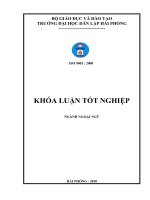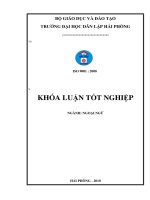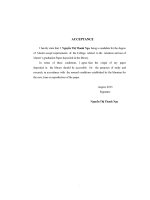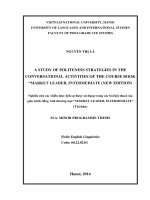A Study on Politeness Strategies in the Conversations of the Course Book “Topnotch 2 Nghiên cứu về chiến lược lịch sự trong các bài hội thoại của giáo trình gia
Bạn đang xem bản rút gọn của tài liệu. Xem và tải ngay bản đầy đủ của tài liệu tại đây (1.42 MB, 75 trang )
VIETNAM NATIONAL UNIVERSITY, HANOI
University of languages and international studies
Faculty of post-graduate studies
VŨ THỊ THANH HUYỀN
A Study on Politeness Strategies in the Conversations of the
Coursebook “Top Notch 2” Pre-intermediate (the First Edition)
Nghiên cứu về chiến lược lịch sự trong các bài hội thoại của
giáo trình giao tiếp “Top Notch 2” Pre-intermediate
(phiên bản đầu tiên)
M.A. MINOR THESIS
Field: English Linguistics
Code: 60.22.15
hanoi – 2013
VIETNAM NATIONAL UNIVERSITY, HANOI
University of languages and international studies
Faculty of post-graduate studies
VŨ THỊ THANH HUYỀN
A Study on Politeness Strategies in the Conversations of
the Coursebook “Top Notch 2” Pre-intermediate (the First
Edition)
Nghiên cứu về chiến lược lịch sự trong các bài hội thoại của
giáo trình giao tiếp “Top Notch 2” Pre-intermediate (phiên bản
đầu tiên)
M.A. MINOR THESIS
Field: English Linguistics
Code: 60.22.15
Supervisor: ĐỖ THỊ THANH HÀ, Ph.D.
Hanoi, 2013
i
DECLARATION
I hereby certify that the thesis entitled
A Study on Politeness Strategies in the Conversations of the Coursebook “Top
Notch 2” Pre-intermediate (the First Edition)
Is the result of my own research in partial fulfillment of the requirement for the
degree of Master of Art at University of Languages and International Studies, VNU
Hanoi.I certify that this thesis has not been submitted for any other degree at any
other university or institution.
Ha Noi, December, 2013
Author‟s signature
Vũ Thị Thanh Huyền
ii
ACKNOWLEGEMENTS
I would like to express my thanks to all those who have assisted me in my
research work.
To my supervisor Dr. Do ThiThanh Ha, I owe a special debt of gratitude for
her great encouragement, constructive guidance and precious comment as well as
suggestionson my thesis writing.
I also wish to acknowledge my deep gratitude to all the teachers of Faculty
of Post-graduate Studies, University of Languages and International Studies, VNU
for furnishing me with valuable knowledge and experience during the course.
My special thanks also go to my colleagues and friends for their assistance in
completing the research.
To all the authors of the publications in the list of references, I offer my
sincere thanks for the ideas from which I have benefited.
My final heart-felt thanks are given to my family members, without whose
moral support, unfailing love and encouragement, I could not have got this far.
iii
ABSTRACT
It is undeniable that English nowadays has become indispensable means of
international communication. However, there are still a large number of Vietnamese
EFL learners who have not achieved success in using English in their
communication since they may face difficulty understanding the content of
conversation or expressing exactly what they mean. One of the significant factors
necessary for students to get more successful in English conversations is the
awareness of politeness strategieswhich are implicitly introduced in textbooks.
The study is conducted using descriptive qualitative research method to find
out politeness strategies in the course book “Top Notch 2” (the First Edition). In
order to fulfill these aims, the author picked up 150 utterances from the sound bites
and the conservation models in the course book to analyze in the light of politeness
theory proposed by Brown and Levinson (1978, 1987). The findings and results of
the study show that most of negative and positive politeness strategies are found in
the conversations and among them positive politeness strategies 4, 5 and 2, negative
politeness strategies 2, 1, and 6 are most frequently used. In addition, the author
also would like to offer some useful implications for effective teaching of positive
and negative politeness strategies.
iv
TABLE OF CONTENTS
*Declaration
i
*Acknowledgements
ii
*Abstract
iii
*Table of contents
iv
*List of abbreviations, tables and figures
vii
PART A: INTRODUCTION
1
1.Rationale
1
2.Aims of the study
2
3.Objective of the study
3
4.Scope of the study
3
5.Significance of the study
3
6.Design of the study
4
PART B: DEVELOPMENT
5
CHAPTER 1: LITERATURE REVIEW
5
1.1.Introduction
5
1.2. Theoretical background
5
1.2.1. Communicative competence
5
1.2.2. An overview of Speech act
6
v
1.2.3. Politeness and politeness strategies
8
1.2.3.1. Politeness
8
1.2.3.2. The concept of face
9
1.2.3.3. Face threatening acts
10
1.2.3.4. Positive politeness and positive politeness strategies
13
1.2.3.5. Negative politeness and negative politeness strategies
17
1.3. Previous study
18
1.4. Summary
24
CHAPTER 2: METHODOLOGY
25
2.1.Introduction
25
2.2. Research questions
25
2.3. Research method
25
2.4. Data-related issues
25
2.4.1. Data sources
25
2.4.2. Data types to be collected
26
2.4.3. Procedure of data collection
26
2.4.4. Data analysis
27
2.5. Summary
27
CHAPTER 3: FINDINGS AND DISCUSSION
28
3.1. Introduction
28
3.2. Findings
28
3.2.1. The use of positive and negative politenessstrategies in the
conversations of “Top Notch 2”(the first edition)
28
vi
3.2.1.1. Positive politeness strategies in the conversations of the course
book “Top Notch 2”(the first edition)
29
3.2.1.2. Negative politeness strategies in the conversations of the course
book “Top Notch 2”(the first edition)
38
3.3. Implications for teaching politeness strategies in thecourse book “Top
Notch 2” (the first edition)
43
3.3.1. Implication for teaching politeness strategies
43
3.3.2. Supplementary exercises and activities for teaching politeness
strategies in the course book “Top Notch 2” (the first edition)
44
3.4. Summary
49
PART C: CONCLUSION
50
1. Introduction
50
2. Summary
50
3. Limitations of the study
51
4. Suggestions for further study
52
REFERENCES
I
APPENDIX
IV
vii
List of Abbreviations, Tables and Figures
List of abbreviations
EFL
English as a foreign language
ESL
English as a second language
S
The speaker
H
The hearer/ Addressee
FTA
Face threatening act
N.P
Negative politeness
P.P
Positive Politeness
P
Page
E.g.
For example
List of tables
Table 1: The proportion of positive and negative politeness strategies
Table 2: The proportion of positive politeness strategies
Table 3: The proportion of negative politeness strategies
List of figures
Figure 1: Circumstances determining choice of strategy
1
PART A: INTRODUCTION
1. Rationale
Language, generally speaking, is created as a necessary demand of human
life with the crucial aim of communication. Since different people from different
cultural and social backgrounds may have different ways to exchange information
and express their attitudes and opinions, the question of how to successfully
communicate in certain contexts, especially in cross-cultural communication has
attracted great attention from linguists and has been widely discussed so far. It is
commonly believed that understanding social conventions and paying attention to
such concepts as politeness and face will definitely allow us to have better
comprehension of a variety of speaking ways by people from different cultures,
thus helping eliminate ethnic stereotypes and misunderstandings. As claimed by
Celce-Murcia and Olshtain (2000), “when learning a second language, one needs to
acquire the new culture politeness framework, which is very different from that of
one‟s own culture”. Obviously, students‟ master of the cultural knowledge in
general and strategies to choose the language politely in particular is supposed to
make a valuable contribution to their ability to well communicate with confidence
in any English speaking environment. With such great importance to language
competence and communication skill, politeness strategies are strongly
recommended to be included in the course designs for teaching and learning English
as a second language in universities and schools.
Among popular course books for English learners, Top Notch series (with
Summit), as claimed by Pearson Longman, is an award-winning six-level
communicative course for adults and young adults. This course book series have
also been used and evaluated by a number of ESL institutes and teachers in the
world. Eslami, Esmaeli, Ghavaminia, and Rajabi (2010) chosed to evaluate the four
mostly instructed courses in Iran English language institutes namelyTop Notch,
Interchange, Headway, and On Your Markbased on Mcdounough and Shaw‟s
2
(2003) division of course book evaluation into internal and external evaluation.
After a thorough examination, the researchers came to the conclusion that“Top
Notch best meets Mcdounough and Shaw‟s (2003) evaluation criteria”.According
to the result of the study by Alemi and Mesbah (2013), the Top Notch series
offered certain benefits to language learners such as “encouraging thestudents to
communicate successfully by giving them lots of opportunities for interaction, and
demonstrating cultural-based aspects not only through lively and authentic visual
images but also without cultural bias” (Alemi&Mesbah, 2013-162).Frommy and
my colleagues ‟personal experiences as English lecturers who have been making
use of these books as text books in the official English teaching program for
students at FPT university for nearly four years, we has got deeply interested in
their effective communicative approach with the main focus on natural and
authentic communication, the promotion of integrated language- skills practice as
well as the inclusion of topical themes in interactive conversations. In order to make
better and more effective use of this course book series in teaching, the author of the
present study has had strong desire for chances of conducting anin-depth study on
these books‟ communicative approach.
All the aforementioned reasons have encouraged the researcher to work on
this study with the objectives of gaining insights into the positive and negative
politeness strategies in the conversations of the course book “Top Notch 2” by Joan
M. Saslow and Allen Ascher -the third book in the Top Notch and Summit series
introduced above.
2. Aims of the study
Firstly, the study is aimed to investigate the politeness strategies utilized in
the conversations of the course book selected. The second aim the study expected to
achieve is to provide teachers with some suggestions for the effective teaching of
polite strategies in the book “Top Notch 2” (the first edition).
3
3. Objectives of the study
In order to achieve the aims mentioned above, the objectives are specified as
follows:
- Identifying and analyzing positive strategies employed in the conversations
of “Top Notch 2” (the first edition).
- Identifying and analyzing negative politeness strategies employed in the
conversations of “Top Notch 2” (the first edition).
- Offering possible implications for teaching positive and negative strategies in
an effective and efficient way with specific exercises related to the content of the
course book.
4. Scope of the study
Politeness strategies which can be presented through verbal and nonverbal
behaviors also can be expressed in different ways by different linguists. The
research is conducted with no ambition to study politeness strategies with various
approaches but it is mainly based on Brown and Levinson‟s theoretical framework.
The focus of this study is limited to investigating only the positive and negative
politeness strategies in the conversation of “Top Notch 2” (the first condition)
without paying much attention to the nonverbal ones.
5. Significance of the study
Once having been completed, this study would give decent benefits. With
respect to English communication teaching, the study is supposed to serve as
noteworthy reference for creating the suitable methods for teaching politeness
strategies in the course book “Top Notch 2”.As for English learner of this course
book, the research hopefully help not only raise the students‟ awareness of the
importance of politeness strategies in cross-cultural communication in general but
also provide them with specific knowledge of politesse strategies accompanied with
their typical words and expressions used in the course book‟s conversation as well
as related exercises and activities for their learning and practising in particular.
4
6. Design of the study report
Part A: Introduction- presents the rationale, aims, objectives, scope,
methods,significance and design of the study.
Part B: Development- consists of three chapters as follows:
Chapter 1: Theoretical background- lays the theoretical foundation for the research.
Chapter 2: Methodology-details the methods that have been used and the
procedures that have been followed by the researcher.
Chapter 3: Findings and discussion – reports the study‟s finding on which further
discussion is offered
Part C: Conclusion: ends the study by summarizing its main points as well
as finding out the limitation and suggestions for the further studies
The following parts are references and appendix .
5
PART B: DEVELOPMENT
Chapter 1: Literature Review
1.1. Introduction
This chapter aims at providing a theoretical background to the research as
well as review of previous related studies, which is necessary for and relevant to the
analysis and interpretation of data.
1.2.Theoretical background
1.2.1. Communicative competence
There have been so far various concepts of communicative competence by
language scholars of different fields. According to Hymes (1967), communicative
competence includes not only knowledge of the linguistics forms of a language but
also its social rules, knowledge of when, how and to whom it is appropriate to use
these forms.
In the context of second language teaching, Canale and Swain (1980) define
communicative competence “a synthesis of knowledge of basic grammatical
principles, knowledge of how language is used in social settings to perform
communicative functions, and knowledge of how utterances and communicative
functions can be combined according to the principles of discourse”. Specifically,
they prescribe this term into four components:
Grammatical competence: reflects the knowledge of the lexicon, syntax and
semantics, or words and rules in general.
Sociolinguistic competence: refers to the appropriateness of communication
depending on the context including the participants and the rules of
interaction.
Discourse competence:involves the cohesion and coherence of utterances in
a discourse or cohesion and coherence in general.









